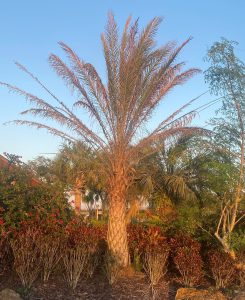Tips from the Help Desk…
What’s killing my palm?
Residential Horticulture Agent and
Master Gardener Volunteer Coordinator
Palm trees are forever a symbol of Florida. Nothing says tropical quite like a palm tree. As sure as I’d want to own an apple tree in Maine, a palm tree must have the same draw for northerners living in Florida. Unfortunately, palms are facing much of the same plight as citrus trees or avocados. Diseases are making them more difficult to grow.
Some palms are dying, and the culprit may be an insect spreading or vectoring the disease. In the case of palms, one of these diseases is called lethal bronzing. To date, it is known to affect 17 species of palm and is spread by a small insect known as a leaf hopper. Insects that spread disease are tough to control because they can inoculate the plants with the disease before we know they

are there. Insects are very mobile and can be carried in the wind. They are good at finding their food, in this case, a palm tree. In the course of feeding on them, they inadvertently infect them. Some other lethal palm diseases can be spread by wind, and pruning equipment.
Lethal bronzing was originally known as Texas Phoenix Palm Decline (TPPD). The disease was known to affect date palms from the genus Phoenix. Since the host plants are no longer just date palms, the name was changed to lethal bronzing which is a description of the way the dying palm appears. Our state palm, the Sabal or cabbage palm is, unfortunately, one of the affected palms.
The first symptoms are the flowers dying and turning black. That is followed by older fronds beginning to die from the bottom up until they get close to the top. At this point, the newest or top fronds may begin to thin and eventually the top or bud collapses. The dying fronds sometimes have a reddish bronze color which is where the name Lethal Bronzing comes from.
This is not the only disease that kills palms but it is becoming one of the more common. To learn more about lethal bronzing click here.
For information on other palm diseases, click here. You can also come to your local Extension office to get help identifying issues you are having with your palms.
Keep in Touch with UF/IFAS Extension, Highlands County
Our Master Gardener Volunteer Help Desk operates Monday – Friday, 9:30 am until 3:30 pm, at 4509 George Blvd., Sebring, Fl. in the Center of the Bert J Harris Jr. Agricultural Center.
That’s what’s new from the Hometown Gardener. Like and Follow me on Facebook at Hometown Gardener.
Read my other blogs by clicking here.
Sign up for our Highlands County Master Gardener Volunteer, “Putting Down Root” Newsletter Here.
Join our Facebook groups Highlands County Master Gardeners, Central Florida Butterfly and Pollinator Club, Science-Based Florida Gardening Answers, and
Source: UF/IFAS Pest Alert
Note: All images and contents are the property of UF/IFAS.



